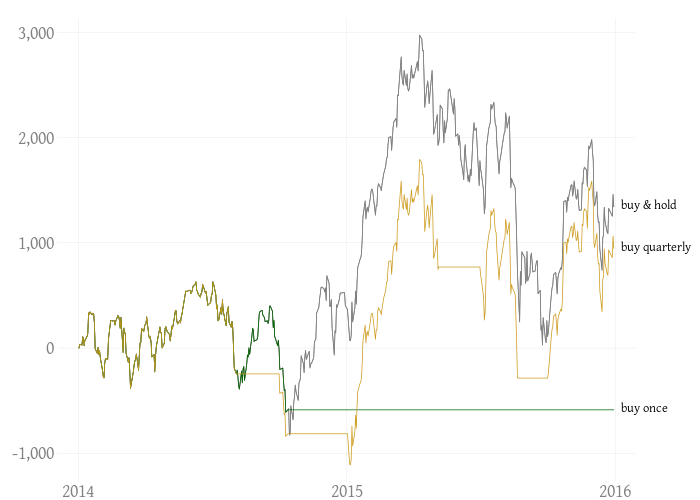Path-dependent strategies
In this note I show how a simple path-dependent
strategy – a stop loss – can be implemented with
btest. To keep it simple, we look only at the
univariate case, i.e. a single time-series. For data,
we use the time-series of the DAX (a German
stock-market index), which is included in the PMwR
package.
library("PMwR") prices <- c(DAX[[1]]) timestamp <- as.Date(row.names(DAX))
The first strategy: buy once, on the first timestamp,
and then sell if the price moves more than stop.loss
percent below the entry price.
buy_once_SL <- function(stop.loss) { if (Time(0) == 1) { Globals$entry <- Close(0) 1 } else if (Portfolio() && Close() < Globals$entry * (1 - stop.loss)) 0 } bt.buy_once_SL <- btest(prices = prices, signal = buy_once_SL, timestamp = timestamp, stop.loss = 0.05, b = 0) journal(bt.buy_once_SL)
instrument timestamp amount price 1 asset 1 2014-01-02 1 9400.04 2 asset 1 2014-10-13 -1 8812.43 2 transactions
Remarks: Since we have a calendar schedule when to buy,
there is no need for a burnin, so b is set to zero.
Also, within the signal function, we test whether
Time(0) equals 1, i.e. we use no lag. The else
clause starts with the test Portfolio(): If we are
not invested (i.e. we have been stopped out), the
position will be zero, which evaluates to FALSE. For
this example, such a test would not have been
necessary, since the second condition is very fast to
compute. But in general, for a path-dependent
strategy, btest needs to loop through every single
data point, and then not doing unnecessary work helps
to speed up things.
Suppose we had wanted a trailing stop, i.e. sell when
stop.loss percent below the highest price observed
after the position was opened. In that case, we simply
would have to update the entry price (which should
then better be named high or reference or something
similar). This update would have to happen whenever we
have an open position. In any case, the entry is stored
in Globals, which is an environment provided by
btest. For our purposes, we can treat it just like a
list, only that it is never copied. Thus, the objects
we put into it are not local, but are persistent
between invocations of the signal function.
In the example above, once we have closed the position,
we will never again invest. Suppose that instead, we
would want to reinstate a new position at the first day
of every quarter. We would need only few changes to
buy_once_SL.
library("datetimeutils") trade.dates <- nth_day(timestamp, period = "quarter", n = "first") buy_quarterly_SL <- function(stop.loss, trade.dates) { if (Timestamp(0) %in% trade.dates) { Globals$entry <- Close(0) 1 } else if (Portfolio() && Close() < Globals$entry * (1 - stop.loss)) 0 } bt.buy_quarterly_SL <- btest(prices = prices, signal = buy_quarterly_SL, timestamp = timestamp, stop.loss = 0.05, trade.dates = trade.dates, b = 0) journal(bt.buy_quarterly_SL)
instrument timestamp amount price 1 asset 1 2014-01-02 1 9400.04 2 asset 1 2014-08-04 -1 9154.14 3 asset 1 2014-10-01 1 9382.03 4 asset 1 2014-10-13 -1 8812.43 5 asset 1 2015-01-02 1 9764.73 6 asset 1 2015-05-06 -1 11350.15 7 asset 1 2015-07-01 1 11180.50 8 asset 1 2015-08-21 -1 10124.52 9 asset 1 2015-10-01 1 9509.25 9 transactions
Note that with this specification, the entry price is
updated every quarter, even when we have not been
stopped out.
Finally, we may want to compare the results with a buy-and-hold strategy. The signal function is so simple that we can inline it.
bt.buy_hold <- btest(prices = prices, signal = function() 1, timestamp = timestamp, b = 0) journal(bt.buy_hold)
instrument timestamp amount price 1 asset 1 2014-01-02 1 9400.04 1 transaction
We plot the resulting equity curves.
library("plotseries") ## https://github.com/enricoschumann/plotseries library("zoo") plotseries(merge(as.zoo(NAVseries(bt.buy_hold)), as.zoo(NAVseries(bt.buy_once_SL)), as.zoo(NAVseries(bt.buy_quarterly_SL))), add0 = TRUE, add1 = FALSE, col = c(grey(0.5), "darkgreen", "goldenrod3"), labels = c("buy & hold", "buy once", "buy quarterly"), add.returns = FALSE, add.dollars = FALSE, big.mark = ",")
